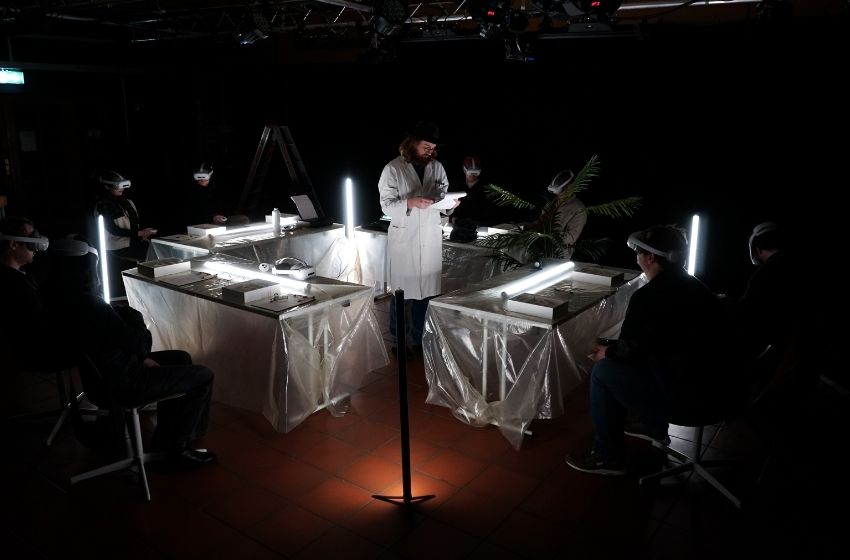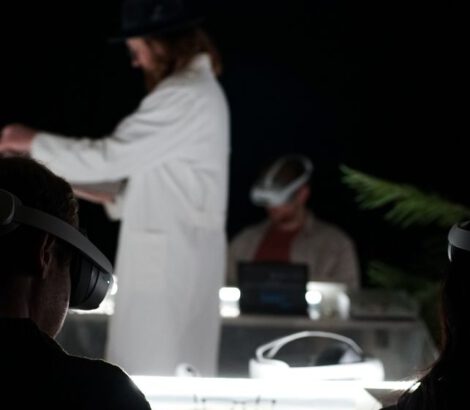
Virtual Stages, Real Interactions: The VR Theater “Ekklesia”
When it comes to digital theater, hardly anyone can fool the Staatstheater Augsburg. With the VR game “Ekklesia”, the theater's digital division mixes elements of theater, radio plays and gaming. I dare to try it out for myself and meet the creative minds behind the project.
I am floating in a white room. Directly in front of me is a small town of pretty houses, a large church, a school and various stores. A windmill and small woods can be seen in the background. I am looking for a place for a huge soccer stadium. I place it on the edge of town by simply pointing at it. Suddenly, an actress dressed as the Greek god appears above my city and praises me for building the sports temple. A few rounds later, the AI assistant Agi, also played by an actor, admonishes me that the city lacks energy, while the capitalist Scrooge wants to see department stores and shopping centers above all else.
One game, many cities: how the VR experience “Ekklesia” works
I experience all of this with VR glasses on my head during the innovative VR set-up game Ekklesia, which the Augsburg State Theatre has been offering in the Old Rock Café since March 14. “Ekklesia” comes from the Greek and means something like ‘place of coming together’, which also fits this evening. Up to eight people can take part in a performance together, which works in a wonderfully analog way away from the virtual world. Two men in white lab coats greet us that evening and start by handing out questionnaires on paper – Ekklesia is embedded in a fictional study by the “International Demographic Institute”. The men explain the technology before everyone builds their own little city in virtual reality.
I and the other participants then sit in the group for about 45 minutes, immersed in the game and experience a story together, but each one individually. This is significantly influenced by the decisions that everyone makes along the way. Instead of the soccer stadium, I could have built a university, a shopping center or a composting plant, which would have changed the course of the story. I repeatedly encounter the characters Dionysus, Scrooge and Agi – played by actors from the State Theatre – who address the tensions between culture, growth and sustainability in their dialogues.
The two “researchers” who welcomed us at the beginning are Benjamin Seuffert and Lukas Baueregger. Seuffert studied Interactive Media at Augsburg University of Applied Sciences and wrote his bachelor's thesis on the topic of “Virtual Reality for the Theater”. Baueregger came to Augsburg in September 2020 as an assistant director. Since 2023, they have jointly managed the Augsburg State Theater's digital division, which is known for its innovative spirit. They developed and implemented the idea for Ekklesia together. After the performance – the third of the evening – I meet them for a chat about Ekklesia, digital theater itself and their vision for the Staatstheater Augsburg.
Of course, Baueregger and Seuffert have already taken off their white coats. Symbolically, however, they would also suit them well outside of the play. Researching and experimenting with new media and possibilities such as VR is an integral part of their everyday work. “We want to find out how stories can be told in new ways through this medium. It's something totally primal and theatrical to say: we have a text, a plot, an image and we're looking at how we can bring it to an audience,” explains Lukas Baueregger.
The production behind it: Sophisticated direction and game programming
In the case of Ekklesia, it would be wrong to speak of a single story. In fact, the project tells a whole series of stories. According to Baueregger, it is almost impossible for two participants to experience exactly the same story. Ekklesia consists of 60 individual scenes that are written and staged in such a way that they can be played in almost any order.
These scenes were created in collaboration with the playwright Robert Rausch, who, according to Baueregger, was exactly the right person for this project. According to Seuffert, his writing is “on the one hand very funny, but also very socially relevant and critical, which is a good combination.” He was also able to maintain an overview of the entire work – a real achievement with such a convoluted structure. While Seuffert did most of the 3D and game programming himself, Baueregger was responsible for directing and production.
The directorial work on Ekklesia was fundamentally different from other stage productions. Although the VR play has a beginning and several endings, different things can happen during the course of the play. This had to be taken into account when recording with the actors. In addition, most of the actors are used to expressing a lot with gestures. However, around two thirds of the scenes are pure sound recordings, where emphasis and flow of speech are much more important.
The work was worth it. In addition to the VR production of “The Sandman”, which was created together with the Augsburger Puppenkiste, Seuffert and Baueregger describe Ekklesia as their biggest success to date since they took over the management of the digital division. “This is our first big project of our own that we came up with and realized from scratch," explains Benjamin Seuffert.
However, the play also highlighted a few obstacles and difficulties that digital theater is still struggling with at the moment. For example, the number of audience members. Only eight people can take part in a performance. No comparison to large productions that are attended by over 500 people every evening.
From a stopgap to a permanent fixture: VR as a new narrative medium for theater
The Digital Theater in Augsburg was surprised by the coronavirus pandemic at an opportune moment, so to speak. They had already invested in VR hardware for a planned production and were quickly able to make a virtue out of necessity. Today, 16 VR productions can be experienced at the Staatstheater. A ticket for the desired VR play and the appropriate glasses can be ordered in the online store. They are delivered to your door on loan along with the necessary instructions. As a viewer, you can enjoy the production in the comfort of your own living room.
At the same time, however, the need for exchange following such VR productions is immense. Ekklesia is an attempt to unite these opposites and – as Baueregger puts it – to create theatrical meeting spaces. For this reason, there are no plans to offer Ekklesia via the ordering service. The aim is for the audience to come together in one room, experience their own stories and share them. “Our constant aim is to use this technology, which is actually made for individuals, in a context in which people can experience something together. But at the same time, you still have the opportunity to tell something individual,” explains Benjamin Seuffert.
Digital theater in Augsburg is taken very seriously and is on a par with theater, opera, ballet and concerts. There is great interest from the theater as well as from the city and the Free State, and the desire to promote digital theater is palpable at all times. Benjamin Seuffert greatly appreciates these opportunities in Bavaria: “We can do something beautiful for the sake of beauty, which makes me happy.”
In addition to sufficient financial resources in the cultural sector, Bavaria as a media location also offers short distances and access to a “cool scene”, as Seuffert puts it. In Augsburg, Munich and throughout Bavaria, he says, he has met many people who are very familiar with the very latest technology. In addition, many companies that offer suitable solutions are based here. This makes it easy to drop by partners' offices and discuss ideas on the spot.
Look into the future – where the VR theater is heading
Towards the end of our conversation, Seuffert and Baueregger venture a look into the future of VR and digital theater. Their hope: to eventually work even more hand in hand with classic stage productions. According to Baueregger, mixed and augmented reality should then play an even more important role.
In this way, the theater should remain a “meeting place” in the future. Expanded with possibilities that are currently being researched in Augsburg. Anyone who is interested and would like to participate directly in this research can immerse themselves in the virtual world of the Staatstheater Augsburg on several dates until July as part of Ekklesia.
Bannerbild: Photo: Staatstheater Augsburg









